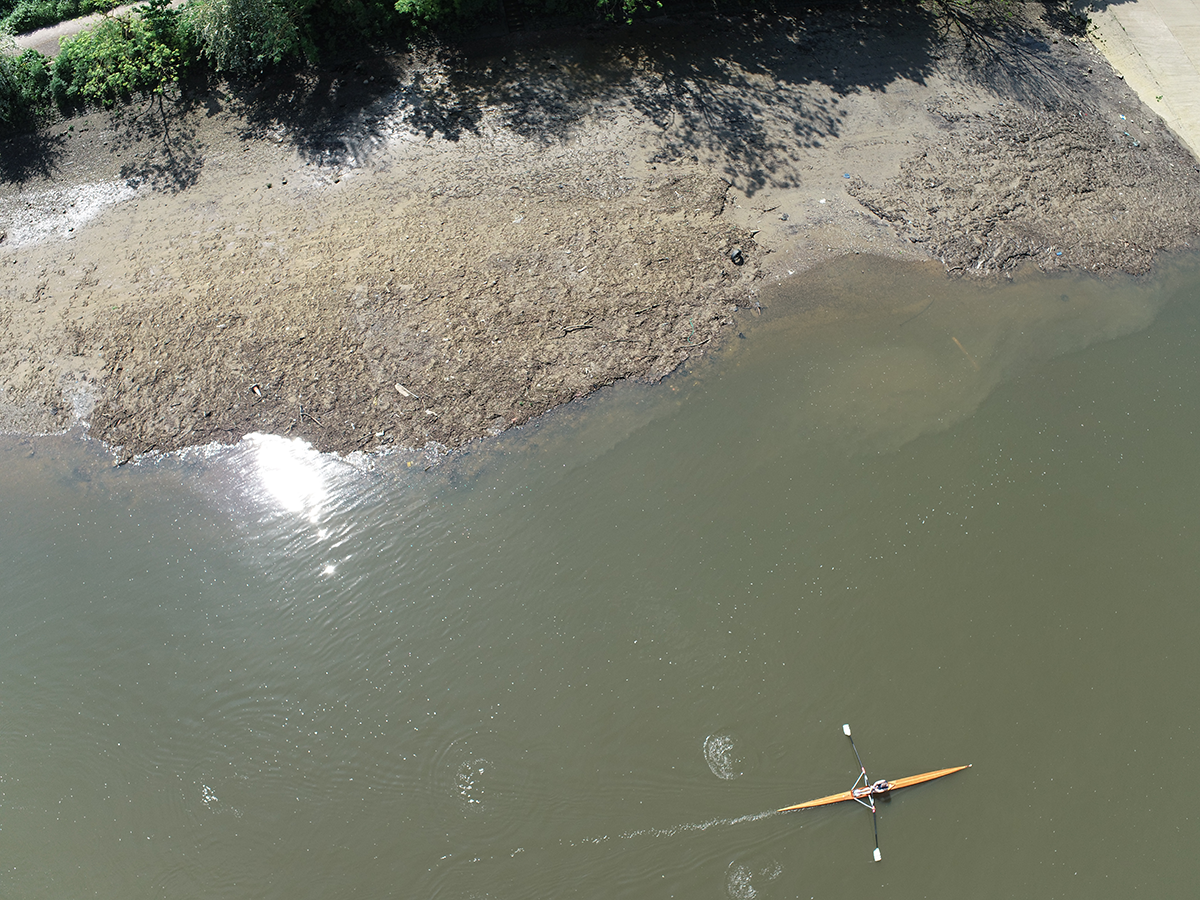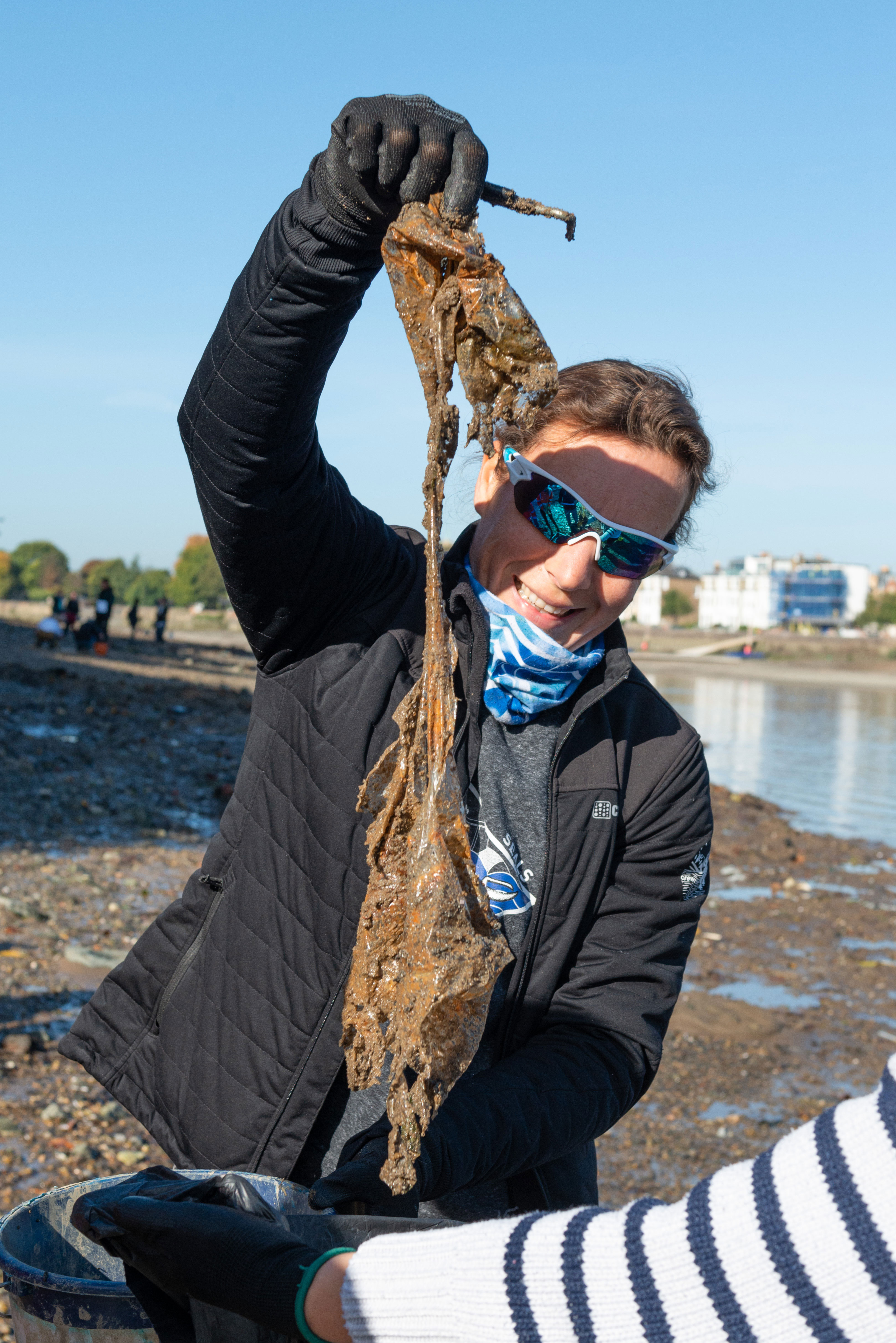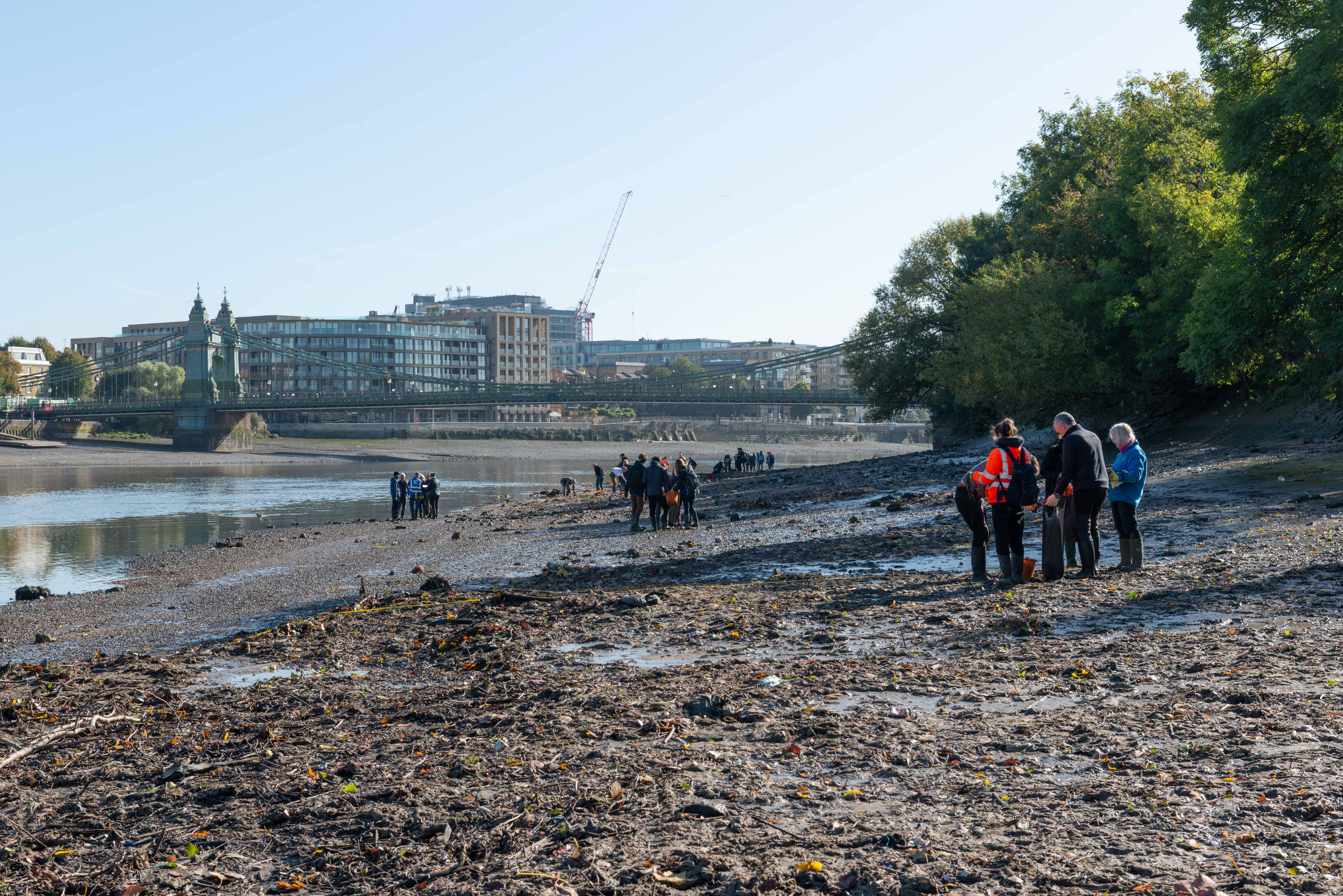First mass wet wipe removal from a UK river launched to clean London’s ‘Wet Wipe Island’

A rower goes past 'Wet Wipe Island' near Hammersmith Bridge
- 180 tonnes of congealed wet wipes – the equivalent to the weight of 15 double decker London buses – are being removed from the River Thames by the Port of London Authority, in collaboration with Thames Water
- The month-long operation is the country’s first mass wet wipe removal project of its kind
- Environmental charity Thames21 and its volunteers have already collected more than 140,000 wet wipes along the Thames and campaigned to clean up the site
Work has started on the mass excavation of London’s Wet Wipe Island in a first-of-its-kind river clean-up project to further improve the quality of the River Thames.
Led and co-ordinated by the Port of London Authority in collaboration with Thames Water, the operation is removing an estimated 180 tonnes of congealed wet wipes that has formed the island along a 250-metre stretch of the tidal Thames near Hammersmith Bridge. It is expected to take up to a month to complete.
The island, which is about the size of two tennis courts, has changed the course of the river and potentially harmed the aquatic wildlife and ecology in the area.
To date, efforts to clean wet wipes from this unique natural environment have relied on people removing them by hand. Inspired by the work of volunteers at Thames 21, the PLA decided to take a lead in co-ordinating larger scale action to remove this unsightly and harmful mess.
The UK’s biggest port, which is responsible for protecting and improving the tidal Thames, commissioned an independent ecological study of the site. This helped inform and develop an environmentally responsible plan to use a mechanical excavator to remove the wet wipes on a mass scale.
Thames21 and its volunteers have been monitoring the island since 2017. Their data and research have played a vital role in raising awareness of how wet wipes containing plastic can degrade the environment and harm wildlife. Their data has also influenced Government policy. It comes after the Government recently published draft legislation to ban wet wipes containing plastic.
Thames 21’s work, alongside expert insights from the PLA’s own hydrography and environmental teams, has proved invaluable in planning the mass removal project.

A volunteer at Wet Wipe Island
St Paul’s School, Barnes is supporting the clean-up and giving access to its grounds to allow the eight-tonne excavator to carefully remove the ‘island’ – which is 1m high in places – from the foreshore when the tide is low. The wet wipes and other pollutants will then be taken away in skips and responsibly disposed of.
This project is part of an ambition to improve river health in the Thames. The PLA’s Clean Thames Manifesto coordinates action across a number of stakeholders towards a clean, pollution free river with a healthy ecosystem by 2050.
Thames Water recently announced a further £1.8billion investment to improve river health across London, and last year connected its £4.6 billion Thames Tideway Tunnel to support the reduction of sewage discharges into the tidal Thames by 95%.
Port of London Authority’s Director of Sustainability, Grace Rawnsley, said: “For too long, ‘Wet Wipe Island’ in Hammersmith has been a source of environmental harm and an embarrassment to the capital. Inspired by the work of volunteers at Thames 21, we decided to take a lead in co-ordinating action to remove this unsightly and harmful mess.
“This is the first time anyone has sought to execute a mass, mechanical removal of wet wipes in this way.
“We want a cleaner, healthier tidal Thames and will continue to work with all interested parties to secure that. And we will continue to bring innovation and investment to help the world’s greatest river thrive.”
Thames Water’s Head of Tideway Integration Group, John Sullivan, said: “Our purpose is to deliver life's essential service, so our customers, communities and the environment can thrive. We are pleased to collaborate with the PLA and Thames21 to remove this mass of wet wipes. For us it is a visible reminder of the damage caused by putting the wrong things down the toilet because flushing something non-biodegradable like a wet wipe doesn’t just make it disappear.
“Blockages caused by wipes are a leading cause of pollution and we remove an estimated 3.8 billion wipes from our network each year.
“We all have a role to play in ensuring that people can enjoy our rivers. Over the next five years Thames Water is targeting a record £9.5 billion (in 2022/23 prices) of investment across our wastewater assets to meet the demands that come with population growth and climate change.”
Chris Coode, CEO at Thames21, said: “Plastic wet wipes have no place in our rivers or natural environment, so it’s terrific news that action is being taken to remove wet wipe island in the Thames.
“This vital move is a crucial step towards protecting the health of the River Thames and its wildlife, as it will reduce the introduction of microplastics into the environment from this site.
“Thames21 and its dedicated volunteers have been building evidence for eight years. We want to give our volunteers a huge shout-out for their persistence. This has been a massive piece of work!
“Thames21 has been pushing for a ban on plastics in wet wipes. However, we would like to see more systemic change to tackle the issue of plastics entering the environment via wet wipes and other sanitary waste.
“We want producers to get serious about plastic-free alternatives to wet wipes. We ask water companies to increase their investment in screening to prevent wet wipes and other sanitary waste which contains plastic entering the environment. We’d also like to see a step-change in their investments in upgrading sewage infrastructure to prevent overflows. We’d like to remind people to bin their sanitary waste and wet wipes, not flush them down the toilet, so that they don’t enter our wastewater system.
“By working together, we can achieve great things for rivers, wildlife and people. Let’s do it!”
Fleur Anderson, MP for Putney, Southfields, Roehampton and Wandsworth Town, said: “This is a huge moment – after years of campaigning, wet wipe island hopefully is no more! It’s so long overdue and very welcome. There was a national outcry at this monstrosity in the Thames – caused by plastic wet wipes, which cause massive damage to our environment and our sewer systems.
“The ban I’ve introduced will mean 3.8 billion wipes removed from the network every year. A win for our waters, sewers and environment!”

Volunteers at Wet Wipe Island
Background information
Thames Water
- As part of Thames Water’s Bin, it, Don’t block it message, it’s important to remember to only flush the three P’s – pee, poo and paper. Flushing away wet wipes, period products or cotton pads can clog pipes, block sewers and pollute rivers and waterways.
- Every year Thames Water clears 3.8 billion wipes from its network, which costs £18 million a year.
- The Thames Tideway Tunnel is 25km long running from Acton to Abbey Mills, up to 67 meters deep in parts and is 7.2 meters wide, the width of three London buses.
- This covers storm overflows from Acton, Putney Bridge and West Putney combined sewer overflows and Hammersmith sewage pumping station so will have a direct impact on this section of the river Thames.
- Tideway has stopped more than 7.8 million cubic meters of sewage into the Thames since August last year.
- In November 2024, the London Tideway Tunnel System, comprising the Thames Tideway and Lee tunnels, intercepted almost 850,000 tonnes of storm sewage in a single day, demonstrating its immediate and critical impact.
PLA
- The PLA is the UK’s biggest port, central to the country’s economy and ambitions for growth. It connects the UK to the world but is much more than a conventional port.
- The PLA is driven by a purpose to protect and improve the 95-mile stretch of the River Thames which is tidal – from Teddington Lock on the border of Surrey, through the heart of London, Kent, Essex and out to the North Sea.
- As a trust port, the PLA reinvest all the money it makes back into the tidal Thames region – caring for the river and supporting the communities who live and work along it.
Thames21
- Thames21 and its volunteers and citizen scientists have collected more than 140,000 wet wipes from around the river since 2017.
- Thames21 is an environmental charity that works with communities to restore and look after rivers, water and nature across London and the Thames Basin.
- www.thames21.org.uk | Registered Charity No. 1103997
